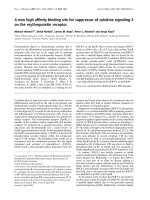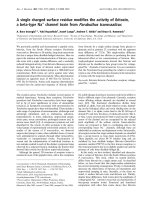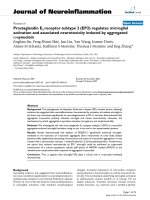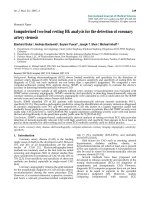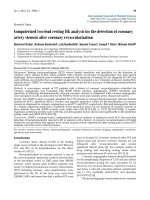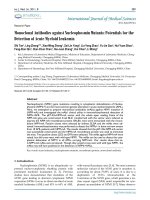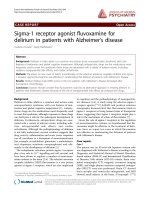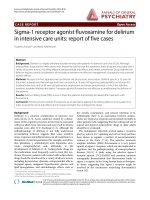Báo cáo y học: "Prostaglandin E2 receptor type 2-selective agonist prevents the degeneration of articular cartilage in rabbit knees with traumatic instability" pptx
Bạn đang xem bản rút gọn của tài liệu. Xem và tải ngay bản đầy đủ của tài liệu tại đây (10.25 MB, 37 trang )
This Provisional PDF corresponds to the article as it appeared upon acceptance. Copyedited and
fully formatted PDF and full text (HTML) versions will be made available soon.
Prostaglandin E2 receptor type 2-selective agonist prevents the degeneration of
articular cartilage in rabbit knees with traumatic instability
Arthritis Research & Therapy 2011, 13:R146 doi:10.1186/ar3460
Hiroto Mitsui ()
Tomoki Aoyama ()
Moritoshi Furu ()
Kinya Ito ()
Yonghui Jin ()
Takayuki Maruyama ()
Toshiya Kanaji ()
Shinsei Fujimura ()
Hikaru Sugihara ()
Akio Nishiura ()
Takanobu Otsuka ()
Takashi Nakamura ()
Junya Toguchida ()
ISSN 1478-6354
Article type Research article
Submission date 19 January 2011
Acceptance date 14 September 2011
Publication date 14 September 2011
Article URL />This peer-reviewed article was published immediately upon acceptance. It can be downloaded,
printed and distributed freely for any purposes (see copyright notice below).
Articles in Arthritis Research & Therapy are listed in PubMed and archived at PubMed Central.
For information about publishing your research in Arthritis Research & Therapy go to
/>Arthritis Research & Therapy
© 2011 Mitsui et al. ; licensee BioMed Central Ltd.
This is an open access article distributed under the terms of the Creative Commons Attribution License ( />which permits unrestricted use, distribution, and reproduction in any medium, provided the original work is properly cited.
Prostaglandin E2 receptor type 2-selective agonist prevents the degeneration
of articular cartilage in rabbit knees with traumatic instability
Hiroto Mitsui
1,3
, Tomoki Aoyama
1,4,*
, Moritoshi Furu
1,2
, Kinya Ito
1,3
, Yonghui Jin
1
,
Takayuki Maruyama
5
, Toshiya Kanaji
5
, Shinsei Fujimura
5
, Hikaru Sugihara
5
, Akio
Nishiura
5
, Takanobu Otsuka
3
, Takashi Nakamura
2
, and Junya Toguchida
1,2,6
.
1
Department of Tissue Regeneration, Institute for Frontier Medical Sciences, Kyoto
University, 53 Kawahara-cho, Shogoin, Sakyo-ku, Kyoto 606-8507, Japan.
2
Department of Orthopaedic Surgery, Graduate School of Medicine, Kyoto University,
54 Kawahara-cho, Shogoin, Sakyo-ku, Kyoto 606-8507, Japan.
3
Department of Orthopaedic Surgery, Graduate School of Medical Sciences, Nagoya
City University, Nagoya, Japan.
4
Department of Physical Therapy, Human Health Sciences, Graduate School of
Medicine, Kyoto University, 53 Kawahara-cho, Shogoin, Sakyo-ku, Kyoto 606-8507,
Japan.
5
Ono Pharmaceutical Co. Ltd.,3-1-1 Sakurai, Shimamoto-cho, Mishima-gun, Osaka
618-8585, Japan.
6
Center for iPS Cell Research and Application, Kyoto University, 53 Kawahara-cho,
Shogoin, Sakyo-ku, Kyoto 606-8507, Japan.
*corresponding author:
Abstract
Introduction: Osteoarthritis (OA) is a common cause of disability in older adults.
We have previously reported that an agonist for subtypes EP2 of the prostaglandin
E2 receptor (an EP2 agonist) promotes the regeneration of chondral and
osteochondral defects. The purpose of the current study is to analyze the effect of
this agonist on articular cartilage in a model of traumatic degeneration.
Methods: The model of traumatic degeneration was established through transection
of the anterior cruciate ligament and partial resection of the medial meniscus of the
rabbits. Rabbits were divided into 5 groups; G-S (sham operation), G-C (no further
treatment), G-0, G-80, and G-400 (single intra-articular administration of gelatin
hydrogel containing 0, 80, and 400µg of the specific EP2 agonist, ONO-8815Ly,
respectively). Degeneration of the articular cartilage was evaluated at 2 or 12 weeks
after the operation.
Results: ONO-8815Ly prevented cartilage degeneration at 2 weeks, which was
associated with the inhibition of matrix metalloproteinase-13 (MMP-13) expression.
The effect of ONO-8815Ly failed to last, and no effects were observed at 12 weeks
after the operation.
Conclusions: Stimulation of prostaglandin E2 (PGE2) via EP2 prevents
degeneration of the articular cartilage during the early stages. With a system to
deliver it long term, the EP2 agonist could be a new therapeutic tool for OA.
{Key words: prostaglandin E2, EP
2
, ONO-8815Ly, osteoarthritis, ACLMT}
Introduction
Osteoarthritis (OA) is the single most common cause of disability in older adults[1].
It is a complex process involving a combination of cartilage degradation, repair, and
inflammation. However, its pathogenesis is not yet fully understood[2]. Articular
cartilage is composed of chondrocytes, and an extensive extracellular matrix (ECM).
The major ECM components are type II collagen and aggrecan. In normal cartilage,
catabolic and anabolic activities are in dynamic equilibrium. Chondrocytes can
produce several catabolic cytokines such as interleukin-1 (IL-1) and tumor necrosis
factor-α (TNF-α), which in turn induce the production of proteinases including matrix
metalloproteinases (MMPs) and disintegrin-like and metalloproteinase with
thrombospondin (ADAMTS), that lead to the destruction of the matrix network[3, 4].
Among the MMPs, MMP-13 (collagenase 3) plays a particularly important role in
causing OA[5]. Indeed, transgenic mice carrying an inducible human MMP-13 gene
develop pathological changes similar to those observed in human OA patients, when
the transgene is expressed in articular cartilages of postnatal mice[6]. Moreover,
inhibitors of MMP-13 prevent the degradation of articular cartilage[5, 7].
Chondrocytes also produce anabolic cytokines such as the bone morphogenetic
protein (BMP) family members and insulin-like growth factor-1 (IGF-1), which induce
the synthesis of collagen and initiate the proliferation of chondrocytes[3]. A
disruption of the equilibrium between the catabolic and anabolic activities results in
catastrophic damage to the articular cartilage, ultimately inducing the pathological
condition known as OA.
Prostanoids, including prostaglandin (PG)D2, PGE1, PGE2, PGF2α,
prostacyclin (PGI2), and thromboxane A2, are lipid mediators produced in a
sequence of cyclooxygenase-1,-2 (COX)-catalyzed reactions[8]. The role of PGE2
in the development of OA is controversial. Some reports point to an important role in
inflammation[9]. Pro-inflammatory signaling mediators such as IL-1 and TNF-α
induce the synthesis of PGE2 by promoting the expression or activities of
cyclooxygenase (COX)-2 and microsomal PGE synthase-1[10]. PGE2 then
promotes IL-1 expression as part of a positive feedback mechanism, degrades the
cartilage ECM[4, 10-13], and finally induces apoptosis of chondrocytes[3]. Other
reports insist that PGE2 opposes the effect of IL-1[14]and stimulates the gene
expression of type II collagen[3, 15]. In addition, PGE2 stimulates the synthesis of
proteoglycan and collagen through the expression of an IGF-1-binding protein[16, 17].
PGE2 works through 4 isoforms of the EP receptor, EP1 to EP4. Previously, we
considered that the controversy could result from differences in the mode of action
and tissue distribution of each receptor [18]. Using an EP2 selective agonist, we
showed that EP2 receptor-mediated PGE2 signaling enhances the growth of
chondrocytes[18, 19] and promotes the regeneration of articular cartilage in rabbits
with cartilage defects[19].
In the current study, we investigate the effect of an EP2 agonist on articular
cartilage in a rabbit model of traumatic degeneration.
Materials and methods
Material
Microspheres loaded with a selective EP2 agonist, ONO-8815Ly (lysine salt)[20],
were prepared by the emulsion-solvent evaporation method[19, 21]. Briefly,
ONO-8815Ly and polylactic-co-glycolic acid (PLGA) were mixed to form a water/oil
emulsion, and added to the outer water phase containing polyvinyl alcohol (PVA)
under stirring with a turbine-shaped mixer at 5000 rpm to obtain a water/oil/water
emulsion. PLGA microspheres that did not contain ONO-8815Ly in its free form were
recovered by centrifugation and lyophilized to remove residual organic solvent and
water. Then, a gelatin aqueous solution (20%, w/w) was poured into the
microsphere suspension to form a gel. For the crosslink reaction, a glutaraldehyde
aqueous solution (12.5 mg/ml) was poured into the microsphere suspension. Small
cylinder-shaped gelatin hydrogels (4 mm in diameter and 2 mm in thickness)
containing ONO-8815Ly (0, 80, or 400 µg of ONO-8815/gel) were obtained by
hollowing out the gelatin hydrogel sheet. Diffusion kinetics analyses showed that
ONO-8815Ly is gradually released from the microsphere over a period of 7 days in
vitro (Figure 1).
Animal model for traumatic degeneration
Four-month-old female Japanese white rabbits (weighing approximately 3 kg) were
used. Traumatic degeneration was induced as described for the anterior cruciate
ligament and menisectomy transection (ACLMT) model [22]. Operations were
performed under general anesthesia, and a skin incision was made on the medial
side of the patella. Soft tissues and articular capsules were cut to expose the knee
joints. The anterior cruciate ligament was transected at the attachment to the tibia in
the knee-flexed position, and the anterior horn of the medial meniscus was resected.
The articular capsule and skin were sutured in layers with 4-0 nylon sutures. After
the operation, rabbits were allowed to move freely. Preliminary experiments
revealed that osteoarthritic changes were observed in this model at as early as 2
weeks after operation (data not shown).
Treatments with the EP2-agonist
A total of 64 animals were randomly assigned to 5 groups: G-S (sham operation),
G-C (no further treatment), G-0, G-80, and G-400 (single intra-articular administration
of gelatin hydrogel containing 0, 80, and 400 µg of ONO-8815Ly, respectively).
Sham-operated rabbits (G-S; N = 4) received no further treatment, and were
sacrificed either 2 (N = 2) or 12 weeks (N = 2) after the operation.
The ACLMT surgery was performed on both the knees of each of the
remaining 60 rabbits to avoid any unequal bearing of weight due to pain on one side.
No further treatment was performed in animals of the control group (G-C; N = 12). In
the treatment groups, no further treatment was performed on the right knee, but a
gelatin hydrogel cylinder containing ONO-8815Ly (G-0, G-80, and G-400; N = 16 per
group) was placed on the fatty pad of the left knee at the time of operation. Rabbits
were sacrificed 2 weeks (G-C, N = 6; G-0, G-80, and G-400, N = 10 per group) or 12
weeks (N = 6 per group) after the operation. All the experiments with animals were
approved by the institutional animal research committee, and performed according to
the Guidelines for Animal Experiments of Kyoto University.
Histological examination
Rabbits were sacrificed 2 or 12 weeks after surgery, and the distal femur and
proximal tibia of the left side of each animal were resected, fixed at 4°C overnight in a
10% formalin solution, and decalcified in formic acid for 3 days. After neutralization
by 10% sodium sulfate for 24 hrs, the samples were embedded in paraffin. Serial
sections were prepared in the coronal plane through the middle of the femoral and
tibia condyles, and one section from each sample was used for each of the
histological analyses. In every section, the entire cartilage portion in full depth was
evaluated. The specimens were stained with safranin O/Fast Green or hematoxylin
and eosin (HE) using standard procedures. The histological grade of cartilage
degeneration was evaluated using the modified Mankin’s scoring system[23], which
was adopted as the original system[24] for the evaluation of the rabbit model. All the
results shown herein represent the combined scoring data of two researchers.
Immunohistochemical analyses
Immunohistochemical examination was performed as follows. In brief, after
deparaffinization, sections were incubated with 0.3% hydrogen peroxide for 30 min.
Then, sections were treated with proteinase K for 2 min (proliferating cell nuclear
antigen [PCNA] staining) or with hyaluronidase for 60 min (MMP staining), after which
they were incubated with the following primary antibodies: mouse anti-human PCNA
monoclonal antibody (1:100; Dako, Glostrup, Denmark), mouse anti-human MMP-13
monoclonal antibody (1:20; AnaSpec Inc., San Jose, CA), or mouse anti-rabbit
MMP-3 monoclonal antibody (1:50; Daiichi Fine Chemical Co. Toyama, Japan). All
antibody dilutions were made in phosphate-buffered saline (PBS). After an
overnight reaction with the primary antibody at 4°C, sections were incubated with
horseradish peroxidase-conjugated anti- mouse IgG (Vector Laboratories, Southfield,
MI) at room temperature for 30 min. Signals were visualized with 3,
3′-diaminobenzidine tetrahydrochloride (DAB), and nuclei were counterstained with
hematoxylin. The percentage of PCNA-, MMP-13-, and MMP-3-positive cells in the
cartilage was calculated by methods similar to those described above. Results of
histological and immunohistochemical analyses were evaluated by two observers
who were blinded to the identity of each sample.
Primary chondrocyte cultures
Primary culture of chondrocytes was performed using articular cartilage tissues
harvested from non-treated rabbits (NRC cells) or ACLMT-operated rabbits (ORC
cells). Briefly, thinly sliced cartilage tissues were incubated with collagenase (4
mg/ml; Sigma Aldrich, St. Louis, MO) in Dulbecco’s modified Eagle’s medium
(DMEM) for 12 hrs. Cells were then collected by centrifugation, seeded into type I
collagen-coated dish (Corning International K.K.,Tokyo, Japan), and cultured with
DMEM containing 10% fetal bovine serum (FBS) supplemented with 100 units/ml
penicillin and 100 mg/ml streptomycin at 37 °C in a humidified atmosphere of 5%
CO
2
/95% air. Chondrocytes were grown in monolayer cultures, and were passaged
when reaching confluence. Cells at the second passage were used for the assay.
ONO-AE1-259-01, a selective agonist of EP2, was used to stimulate EP2 signaling in
the presence or absence of IL-1β (Sigma Aldrich).
Real-time PCR
Total RNA was extracted from cultured cells using the RNeasy kit (Qiagen, Valencia,
CA) according to the manufacturer’s protocol. All reverse transcription (RT) reactions
were performed with an RT-PCR kit using 1 µg of total RNA with a Superscript II
reverse transcriptase (Invitrogen, Carlsbad, CA) for conversion into cDNA. The
mRNA expression levels of MMP-13 and glyceraldehyde 3-phosphate
dehydrogenase (GAPDH) were quantified by real-time PCR using SYBR Green
(Applied Biosystems, Foster City, CA) and the ABI 7500 Real-Time PCR System
(Applied Biosystems). All reactions were run in triplicate, and the amount of PCR
product of each gene was calculated using the standard curve method and
normalized to GAPDH levels, which were used as an internal control. Using the
ratio obtained for the untreated sample as a standard (1.0), the relative ratio of the
treated samples was presented as the relative expression levels of the MMP-13 gene.
Sequences of primers used in this experiment were as follows:
5′-aggagcatggcgacttctac-3′ and 5′-taaaacagctccgcatcaa-3′ (MMP-13) and
5′-gctctccagaacatcactcctgcc-3′ and 5′-cgttgtcataccaggaaatgagct-3′ (GAPDH).
Statistical analysis
The statistical analyses were performed using the Statcel2 software. The results are
shown as the mean ± standard deviation (SD). The Kruskal–Wallis test was
performed for screening purposes, and the Steel–Dwass method for multiple
comparisons was used if there was a significant difference between samples. A p
value < 0.05 was considered to be significant.
Results
Therapeutic effect of ONO-8815Ly in the early stages of degeneration
At 2 weeks after the operation, articular cartilages in medial condyles of G-C (Figure
2A, b) and G-0 (Figure 2A, c) showed severe degenerative findings such as surface
irregularity including clefts and reactive changes such as clonal proliferation of
chondrocytes. The intensity of safranin O staining was reduced in G-C (Figure 2A,
g) and G-0 (Figure 2A, h). The grade of degenerative findings was less prominent in
sections of G-S (Figure 2A, a), G-80 (Figure 2A, d) and G-400 (Figure 2A, e) than in
those of G-C or G-0. Safranin O staining was stronger in sections of G-80 (Figure
2A, i) and G-400 (Figure 2A, j). Similar findings were observed in sections prepared
from lateral femoral condyles. The degenerative changes were less prominent and
the safranin O staining was stronger in sections of G-S (Figure 2B a and f), G-80
(Figure 2B, d and i) and G-400 (Figure 2B, e and j) than in those of G-C (Figure 2B, b
and g) or G-0 (Figure 2B, c and h).
Histological grade was evaluated using a modified Mankin’s scoring
system[24]. The grades of medial condyle in each sample were scored and mean
values were compared (Figure 2C). Scores were significantly better for G-80 than
for G-0. The effect of ONO-8815Ly was more prominent in lateral condyles, and
both G-80 and G-400 showed much better scores than G-C or G-0 (Figure 2D).
Similar findings were observed in medial (Figure 3A) and lateral (Figure 3B)
condyles of tibiae. The degenerative changes were less prominent and the safranin
O staining was stronger in sections of ONO-8815Ly-treated groups (G-80 and G-400)
than in those of non-treated groups (G-C and G-0). The effect of ONO-8815Ly was
similar between G-0 and G-80 in medial condyles (Figure 3C), whereas G-80 and
G-400 showed better values than G-C or G-0 in lateral condyles (Figure 3D). These
results suggested that ONO-8815Ly prevents degenerative change in articular
cartilages during the early stages.
Therapeutic effect of ONO-8815Ly in the late stages of degeneration
Similar analyses were performed using sections prepared at 12 weeks after-surgery.
In the case of femoral condyles, no improvements of cartilage degeneration were
observed in sections of ONO-8815Ly-treated groups (G-80 or G-400) (Figure 4A, d
and e) and the staining of safranin O also showed no difference (Figure 4A, i and j).
Similar results were obtained in lateral condyles of femora (Figure 4B). In
agreement, there was no significant difference in Mankin’s score in the analyses of
medial (Figure 4C) or lateral (Figure 4D) condyles of femora.
Similar results were obtained in the tibiae. Neither medial nor lateral
condyles showed better histological features by the treatment with ONO-8815Ly, and
the Mankin’s score showed no improvements (data not shown).
These results suggested that the effect of ONO-8815Ly failed to last, at least
when using this drug delivery system.
Growth promoting effect of ONO-8815Ly
The proliferating activity of chondrocytes was evaluated by PCNA staining (Figure 5).
The proportion of PCNA-positive cells in femoral (Figure 5A and 5B) and in tibial
(Figure 5C and 5D) condyles at 2 weeks after operation were similar among all
groups, suggesting that the improvement of cartilage degeneration by the EP2
agonist was not due to the acceleration of cell proliferation.
EP2- selective agonist inhibits the expression of MMP-13 in ACLMT
MMP-3 and MMP-13 are major proteases degrading the ECM. The expression of
these enzymes was analyzed by immunohistochemistry using samples prepared at 2
weeks after the operation. For MMP-3, there were no significant differences in
staining intensity or number of positive cells between any of the groups (Figure 6).
For MMP-13, however, significant differences were observed (Figure 7). The
staining of MMP-13 was much stronger in G-C and G-0 (Figure 7A, b and c) than in
G-S, G-80, or G-400 (Figure 7A, a, d, and e). The proportion of MMP-13-positive
cells was significantly lower in sections of G-80 and G-400 than in sections of G-C or
G-0 (Figure 7B). Similar results were obtained for the intensity (Figure 7A, f, i, and j)
and the ratio of MMP-13-positive cells (Figure 7C) in the analyses of lateral condyles.
EP2-selective agonist inhibits IL-1β-induced MMP-13 mRNA expression
To confirm the effect of EP2 agonist on MMP-13 expression, the expression of the
MMP-13 gene by primary cultured chondrocytes was evaluated by quantitative
real-time PCR (Figure 8). The expression levels of MMP-13 were similar in NRC
and ORC cells under basal culture conditions. Similarly, EP2 agonist treatment
showed no significant effects on MMP-13 levels on either cells. When NRC and
ORC cells were treated with IL-1β (50 pg/ml), the expression levels of MMP-13
mRNA were significantly increased in both cells. IL-1β-induced expression of
MMP-13 mRNA in ORC cells was reduced by co-treatment with the EP2 agonist in a
dose-dependent manner, and the maximum reduction was 37% at 1 µM of EP2
agonist. In the case of NRC cells, the maximum reduction (27%) was observed at
the concentration of 0.1 µM.
Discussion
The effect of PGE2 on the progression of OA is still a matter of debate. In some
reports, PGE2 was shown to destroy articular cartilage by degrading cartilage
ECM[12, 13]. It has also been reported to down-regulate the production of IL-6 by
IL-1α and IL-1β via EP2/EP4 receptors[25, 26]. PGE2 at very low concentrations
inhibits the production of IL-1β, TNF-α, and MMP-13 in the articular cartilages of OA
patients[27]. In the current study, the production of MMP-13 was decreased by an
EP2 agonist (Figure 7 and 8), which is consistent with the in vitro data described in a
recent report [28]. Continuous administration of non-steroidal anti-inflammatory
drugs to patients with OA exacerbates OA[29, 30]. These contradictory results may
be due to the differences in the experimental dose of PGE2 agonist used, or due to
the pleiotropic effects of PGE2 through different types of receptors, (EP1 through
EP4). Therefore analyses should be done with agonists specific for each type of
receptor. IL-1β-induced expression of MMP-13 mRNA was reduced by EP2
signaling both in NRC and ORC cells in vitro (Figure 8). Moreover, IL-1β-induced
expression of MMP-13 mRNA was reduced in ORC cells, but not in NRC cells, in a
dose-dependent manner, i.e., MMP-13 expression was higher in the presence of 1
µM of ONO-AE-259-01 than in the presence of 0.1 µM of ONO-AE-259-01 (Figure 8).
An EP2 agonist acts as an anti-inflammatory drug at low doses, but if the
concentration exceeds 1 µM, the anti-inflammatory effect may become weak (Figure
8). In fact, some authors have reported that excess EP2 agonists may act rather as
inflammatory-inductive drugs.
Previously, we showed that EP2 signaling enhances the growth of
chondrocytes[18, 19] and promotes the regeneration of articular cartilage in rabbits
with cartilage defects by an EP2-selective agonist[19]. However, in the current
study, EP2 signaling failed to promote chondrocyte proliferation (Figure 5). The
differences may result from differences in the animal models. In the previous study,
the effect of EP2 signaling on articular cartilage was evaluated using the chondral
and osteochondral defect models. In that model, cartilage defects are present
before initiation of the treatment with an EP2 agonist. Thus, EP2 signaling may
promote cartilage regeneration by inducing proliferation of cartilage chondrocytes and,
consequently, contributing to ECM reconstruction. On the other hand, in the present
study, the articular chondrocytes appeared normal immediately after the ACLMT
operation, and EP2 signaling reduced cartilage degeneration caused by traumatic
instability of the knee joint. These differences in models might be the cause of
difference in the results.
In the present study, the abnormal stress on cartilage tissues induced by
joint instability was the main cause of degeneration. The degeneration was more
remarkable in the lateral (Figs. 2D and 3D) than in the medial components (Figs. 2C
and 3C), wherein partial meniscectomy was performed. We have no clear
explanation for this result. A study has shown that the lateral components of the
rabbit knees were more susceptible to degeneration than the medial components in
the ACLT model[31]. The rabbit knee joints are physiologically in the valgus position,
causing excess load on the lateral side, which might explain the susceptibility.
The grade of degeneration at 12 weeks was less prominent than we
expected (Figure 4). In this injury model, cartilage degeneration will be induced by
abnormal stress due to joint instability. Such abnormal stress takes place during
weight-bearing movements of the knee joints. Therefore, to enhance such stress,
Park et al. forced the rabbits to move in a confined space (5 m × 5 m) for 1 h twice a
day, from 3 days after ACLMT onward [22], which increased the Mankin’s score up to
12 points at 8 weeks after the operation. Restriction in a small cage in the
knee-flexed position, as in our study, may minimize such stresses. In addition, both
knees were operated, which may further decrease the activities of the rabbits.
These may cause almost no progression of the disease after 2 weeks.
Generally, cartilage degeneration in OA is due to the induction of MMP
expression. MMP-13 is a product of chondrocytes that reside in cartilage and has a
stronger effect that MMP-1 on type II collagen[32]. Some insisted that PGE2 exerts
direct inhibitory effects on the expression of MMP-1[33, 34] and MMP-13[28, 33, 34]
in arthritic chondrocytes, and Sato et al. demonstrated that EP2 signaling was
responsible for the down-regulation of MMP-13 in vitro, although they used a different
agonist[28]. Taken together, EP2 signaling regulates MMP-13 production. In
agreement, we showed that production of MMP-13 in articular chondrocytes was
reduced when treated with an EP2 agonist in vivo (Figure7) and in vitro (Figure 8).
Controversially others studies show that PGE2 plays a crucial role in the induction of
MMP-13 and MMP-3 in chondrocytes in response to IL-1β in microsomal
prostaglandin E synthase-(mPGES-1)-deficient mice[35] or that of PGE2 inhibits
chondrocyte maturation[36]. In the current study model, EP2 signaling was shown
to inhibit the expression of MMP-13 mRNA, suggesting that EP2 signaling protects
the articular cartilage from degeneration.
MMP-3 is a protease expressed in OA specimens at an early stage[37, 38].
MMP-3 cleaves a variety of ECM components such as proteoglycans, collagens and
procollagens[39]. In the current study, ONO-8815Ly had no effect on the production
of MMP-3 (Figure 6). Although there is still much to be done, the current study
suggested that an EP2 agonist may exert a protective effect on articular cartilage by
inhibiting MMP-13.
It is important to clarify whether an EP2 agonist caused inflammation either
systemically or locally. PGs are pro-inflammatory lipid mediators whose levels
increase in the synovial membrane and synovial fluid of patients with OA. We
previously reported that intra-articular administration of an EP2 agonist did not affect
the mRNA expression of the MMP-3, TIMP-3, and IL-1β genes in the synovium, or
the amounts of TNF-α and C-reactive protein (CRP) in joint fluids. As in our
previous study, we found no severe inflammatory changes in the synovium, and no
change in the levels of CRP (data not shown), suggesting that this EP2 agonist
caused no inflammation either systemically or locally.
The effect of an EP2 agonist did not last long (Figure 4), yet this may be
rectified by developing a suitable drug delivery system. Continuous administration
of an EP2 agonist using such a newly developed system could provide a novel
therapeutic modality to treat OA.
Conclusions
Stimulation of PGE2 via EP2 prevents degeneration of the articular cartilage during
the early stages. The current study suggests that EP2 agonists may exert a
protective effect on articular cartilage by inhibiting MMP-13. With a long-term
delivery system, the EP2 agonist could be a new therapeutic tool for OA.
Abbreviations
ACLMT: anterior cruciate ligament and menisectomy transaction; EP2: prostaglandin
E2 receptor type 2; MMP-13: matrix metalloproteinase-13; PGE2: prostaglandin E2;
PLGA: polylactic-co-glycolic acid.
Authors’ contributions
HM performed animal experiments, carried out analysis and interpretation of the data,
and drafted the manuscript. TA conceived this study, designed the study, carried out
analysis and interpretation of the data, and drafted the manuscript. MF and JY
performed animal experiments and carried out analysis of the data. KI performed
animal experiments. TM was the chief investigator in the development of materials,
and conceived this study. TK designed and performed animal experiments. SF
performed animal
experiments and obtained samples from animals. HS was
responsible for providing materials. NA was responsible for the development of drug
delivery system. TO carried out administrative and financial support and helped to
draft the manuscript. TN carried out administrative and financial support and helped
to draft the manuscript. JT conceived this study, provided financial support,
designed experiments, interpreted the data, and drafted the manuscript. All authors
have read and approaved the manuscript for publication.
Competing interests
Takayuki Maruyama, Toshiya Kanaji, Shinsei Fujimura, Hikaru Sugihara, and Akio
Nishiura
are employees of Ono Pharmaceutical Co. Ltd. All other authors have no
conflicts of interest.
Acknowledgements
We are grateful to Tomohisa Kato, Akira Nasu, Takashi Kasahara, Kazuo Hayakawa,
Kyosuke Kobayashi, Michiko Ueda, Sakura Tamaki, and Yukiko Kobayashi for their
assistance. This work was partially supported by Grants-in-aid for Scientific
Research from the Japan Society for the Promotion of Science, from the Ministry of
Education, Culture, Sports, Science, and Technology, and from the Ministry of Health,
Labor, and Welfare.
References
1. Peat G, McCarney R, Croft P: Knee pain and osteoarthritis in older adults:
a review of community burden and current use of primary health care.
Ann Rheum Dis 2001, 60:91-97.
2. Buckwalter JA, Saltzman C, Brown T: The impact of osteoarthritis:
implications for research. Clin Orthop Relat Res 2004(427 Suppl):S6-15.
3. Goldring SR, Goldring MB: The role of cytokines in cartilage matrix
degeneration in osteoarthritis. Clin Orthop Relat Res 2004(427
Suppl):S27-36.
4. Goldring MB, Goldring SR: Osteoarthritis. J Cell Physiol 2007, 213:626-634.
5. Billinghurst RC, Dahlberg L, Ionescu M, Reiner A, Bourne R, Rorabeck C,
Mitchell P, Hambor J, Diekmann O, Tschesche H, Chen J, Van Wart H, Poole
AR: Enhanced cleavage of type II collagen by collagenases in
osteoarthritic articular cartilage. J Clin Invest 1997, 99:1534-1545.
6. Neuhold LA, Killar L, Zhao W, Sung ML, Warner L, Kulik J, Turner J, Wu W,
Billinghurst C, Meijers T, Poole AR, Babij P, DeGennaro LJ.: Postnatal
expression in hyaline cartilage of constitutively active human
collagenase-3 (MMP-13) induces osteoarthritis in mice. J Clin Invest 2001,
107:35-44.
7. Hu Y, Xiang JS, DiGrandi MJ, Du X, Ipek M, Laakso LM, Li J, Li W, Rush TS,
Schmid J , Skotnicki JS, Tam S, Thomason JR, Wang Q, Levin JI: Potent,
selective, and orally bioavailable matrix metalloproteinase-13 inhibitors
for the treatment of osteoarthritis. Bioorg Med Chem 2005, 13:6629-6644.
8. Narumiya S, Sugimoto Y, Ushikubi F: Prostanoid receptors: structures,
properties, and functions. Physiol Rev 1999, 79:1193-1226.
9. Laufer S: Role of eicosanoids in structural degradation in osteoarthritis.
Curr Opin Rheumatol 2003, 15:623-627.
10. Martel-Pelletier J, Pelletier JP, Fahmi H: Cyclooxygenase-2 and
prostaglandins in articular tissues. Semin Arthritis Rheum 2003,
33:155-167.
11. Bunning RA, Russell RG: The effect of tumor necrosis factor alpha and
gamma-interferon on the resorption of human articular cartilage and on
the production of prostaglandin E and of caseinase activity by human
articular chondrocytes. Arthritis Rheum 1989, 32:780-784.
12. Lippiello L, Yamamoto K, Robinson D, Mankin HJ: Involvement of
prostaglandins from rheumatoid synovium in inhibition of articular
cartilage metabolism. Arthritis Rheum 1978, 21:909-917.
13. Li X, Ellman M, Muddasani P, Wang JH, Cs-Szabo G, van Wijnen AJ, Im HJ:
Prostaglandin E2 and its cognate EP receptors control human adult
articular cartilage homeostasis and are linked to the pathophysiology of
osteoarthritis. Arthritis Rheum 2009, 60:513-523.
14. Riquet FB, Lai WF, Birkhead JR, Suen LF, Karsenty G, Goldring MB:
Suppression of type I collagen gene expression by prostaglandins in
fibroblasts is mediated at the transcriptional level. Mol Med 2000,
6:705-719.
15. Miyamoto M, Ito H, Mukai S, Kobayashi T, Yamamoto H, Kobayashi M,
Maruyama T, Akiyama H, Nakamura T: Simultaneous stimulation of EP2
and EP4 is essential to the effect of prostaglandin E2 in chondrocyte
differentiation. Osteoarthritis Cartilage 2003, 11:644-652.
16. Di Battista JA, Dore S, Morin N, He Y, Pelletier JP, Martel-Pelletier J:
Prostaglandin E2 stimulates insulin-like growth factor binding protein-4
expression and synthesis in cultured human articular chondrocytes:
possible mediation by Ca(++)-calmodulin regulated processes. J Cell
Biochem 1997, 65:408-419.
17. Lowe GN, Fu YH, McDougall S, Polendo R, Williams A, Benya PD, Hahn TJ:
Effects of prostaglandins on deoxyribonucleic acid and aggrecan
synthesis in the RCJ 3.1C5.18 chondrocyte cell line: role of second
messengers. Endocrinology 1996, 137:2208-2216.
18. Aoyama T, Liang B, Okamoto T, Matsusaki T, Nishijo K, Ishibe T, Yasura K,
Nagayama S, Nakayama T, Nakamura T, Toguchida J: PGE2 signal through
EP2 promotes the growth of articular chondrocytes. J Bone Miner Res
2005, 20:377-389.
19. Otsuka S, Aoyama T, Furu M, Ito K, Jin Y, Nasu A, Fukiage K, Kohno Y,
Maruyama T, Kanaji T , Nishiura A, Sugihara H, Fujimura S, Otsuka T,
Nakamura T, Toguchida J: PGE2 signal via EP2 receptors evoked by a
selective agonist enhances regeneration of injured articular cartilage.
Osteoarthritis Cartilage 2009, 17:529-538.
20. Tani K, Naganawa A, Ishida A, Egashira H, Sagawa K, Harada H, Ogawa M,
Maruyama T, Ohuchida S, Nakai H , Kondo K, Toda M: Design and synthesis
of a highly selective EP2-receptor agonist. Bioorg Med Chem Lett 2001,
11:2025-2028.
21. Okada H: One- and three-month release injectable microspheres of the
LH-RH superagonist leuprorelin acetate. Adv Drug Deliv Rev 1997,
28:43-70.
22. Park SR, Park SH, Jang KW, Cho HS, Cui JH, An HJ, Choi MJ, Chung SI, Min
BH: The effect of sonication on simulated osteoarthritis. Part II:
alleviation of osteoarthritis pathogenesis by 1 MHz ultrasound with
simultaneous hyaluronate injection. Ultrasound Med Biol 2005,
31:1559-1566.
23. Sakakibara Y, Miura T, Iwata H, Kikuchi T, Yamaguchi T, Yoshimi T, Itoh H:
Effect of high-molecular-weight sodium hyaluronate on immobilized
rabbit knee. Clin Orthop Relat Res 1994(299):282-292.
24. Mankin HJ, Dorfman H, Lippiello L, Zarins A: Biochemical and metabolic
abnormalities in articular cartilage from osteo-arthritic human hips. II.
Correlation of morphology with biochemical and metabolic data. J Bone
Joint Surg Am 1971, 53:523-537.
25. Noguchi K, Maeda M, Ruwanpura SM, Ishikawa I: Prostaglandin E2 (PGE2)
downregulates interleukin (IL)-1alpha-induced IL-6 production via
EP2/EP4 subtypes of PGE2 receptors in human periodontal ligament
cells. Oral Dis 2005, 11:157-162.
26. Noguchi K, Shitashige M, Endo H, Kondo H, Ishikawa I: Binary regulation of
interleukin (IL)-6 production by EP1 and EP2/EP4 subtypes of PGE2
receptors in IL-1beta-stimulated human gingival fibroblasts. J Periodontal
Res 2002, 37:29-36.
27. Tchetina EV, Di Battista JA, Zukor DJ, Antoniou J, Poole AR: Prostaglandin
PGE2 at very low concentrations suppresses collagen cleavage in
cultured human osteoarthritic articular cartilage: this involves a
decrease in expression of proinflammatory genes, collagenases and
COL10A1, a gene linked to chondrocyte hypertrophy. Arthritis Res Ther
2007, 9:R75.
28. Sato T, Konomi K, Fujii R, Aono H, Aratani S, Yagishita N, Araya N, Yudoh K,
Beppu M, Yamano Y , Nishioka K, Nakajima T: Prostaglandin EP2 receptor
signalling inhibits the expression of matrix metalloproteinase 13 in
human osteoarthritic chondrocytes. Ann Rheum Dis, 70:221-226.
29. Rashad S, Low F, Revell P, Hemingway A, Rainsford K, Walker F: Effect of
non-steroidal anti-inflammatory drugs on course of osteoarthritis. Lancet
1989, 2:1149.
30. Reijman M, Bierma-Zeinstra SM, Pols HA, Koes BW, Stricker BH, Hazes JM:
Is there an association between the use of different types of nonsteroidal
antiinflammatory drugs and radiologic progression of osteoarthritis?
The Rotterdam Study. Arthritis Rheum 2005, 52:3137-3142.
31. Shirai T, Kobayashi M, Nishitani K, Satake T, Kuroki H, Nakagawa Y,
Nakamura T: Chondroprotective effect of alendronate in a rabbit model of
osteoarthritis. J Orthop Res 2011, 29:1572-7.
32. Burrage PS, Mix KS, Brinckerhoff CE: Matrix metalloproteinases: role in
arthritis. Front Biosci 2006, 11:529-543.
33. Nishitani K, Ito H, Hiramitsu T, Tsutsumi R, Tanida S, Kitaori T, Yoshitomi H,
Kobayashi M, Nakamura T: PGE2 inhibits MMP expression by suppressing
MKK4-JNK MAP kinase-c-JUN pathway via EP4 in human articular
chondrocytes. J Cell Biochem, 109:425-433.
34. Pillinger MH, Rosenthal PB, Tolani SN, Apsel B, Dinsell V, Greenberg J, Chan
ES, Gomez PF, Abramson SB: Cyclooxygenase-2-derived E
prostaglandins down-regulate matrix metalloproteinase-1 expression in
fibroblast-like synoviocytes via inhibition of extracellular
signal-regulated kinase activation. J Immunol 2003, 171:6080-6089.
35. Gosset M, Pigenet A, Salvat C, Berenbaum F, Jacques C: Inhibition of matrix
metalloproteinase-3 and -13 synthesis induced by IL-1beta in
chondrocytes from mice lacking microsomal prostaglandin E synthase-1.
J Immunol, 185:6244-6252.
36. Clark CA, Li TF, Kim KO, Drissi H, Zuscik MJ, Zhang X, O'Keefe RJ:
Prostaglandin E2 inhibits BMP signaling and delays chondrocyte
maturation. J Orthop Res 2009, 27:785-792.
37. Bau B, Gebhard PM, Haag J, Knorr T, Bartnik E, Aigner T: Relative
messenger RNA expression profiling of collagenases and aggrecanases
in human articular chondrocytes in vivo and in vitro. Arthritis Rheum 2002,
46:2648-2657.
38. Kevorkian L, Young DA, Darrah C, Donell ST, Shepstone L, Porter S,
Brockbank SM, Edwards DR, Parker AE, Clark IM: Expression profiling of

